External Load of Flamenco Zap-3 Footwork Test: Use of PlayerLoad Concept with Triaxial Accelerometry
Abstract
1. Introduction
2. Materials and Methods
2.1. Participants
2.2. Procedures
2.3. Flamenco Zap-3 Footwork
- (1)
- Zapateado de planta (P);
- (2)
- Zapateado de Tacón-planta (TP);
- (3)
- Zapateado de Tacón (T);
- (4)
- Zapateado de Tacón-planta (TP);
- (5)
- Zapateado de Punta (PNT);
- (6)
- Zapateado de Tacón-planta (TP).
2.4. Data Processing
2.5. Statistical Analysis
3. Results
3.1. Zap-3 Footwork Load Responses—Total PlayerLoad
3.2. Zap-3 Footwork Load Responses—Uniaxial PlayerLoad
3.3. Zap-3 Footwork Load Responses—Uniaxial Contributions
4. Discussion
5. Conclusions
Author Contributions
Funding
Institutional Review Board Statement
Informed Consent Statement
Data Availability Statement
Acknowledgments
Conflicts of Interest
References
- Baena-Chicón, I. Tratamiento coreográfico en el baile Flamenco. Telethusa Rev. Cent. Investig. 2016, 9, 11–14. [Google Scholar]
- Pedersen, M.E.; Wilmerding, V. Injury profiles of student and professional flamenco dancers. J. Danc. Med. Sci. 1998, 2, 108–114. [Google Scholar]
- Pedersen, M.E.; Wilmerding, M.; Kuhn, B.T.; Enciñias-Sandoval, E. Energy requirements of the American professional flamenco dancer. Med. Probl. Perform. Artist. 2001, 16, 47–52. [Google Scholar] [CrossRef]
- Vargas-Macías, A. El Baile Flamenco: Estudio Descriptivo, Biomecánico y Condición Física; Centro de Investigación Flamenco Teelthusa: Cádiz, Spain, 2009. [Google Scholar]
- Koutedakis, Y.; Jamurtas, A. The dancer as a performing athlete. Sports Med. 2004, 34, 651–661. [Google Scholar] [CrossRef] [PubMed]
- Vargas-Macías, A.; Montesinos, J.L.G.; Vicente, J.M.; Lozano, S.G. La necesidad de la preparación física en el baile flamenco. Rev. Cent. Investig. Flamenco Telethusa 2008, 1989, 1628. [Google Scholar]
- Nogareda, S.; Salas, C.; Parra, J. La salud laboral en el arte flamenco. In Nota Técnica de Prevención-756; Instituto Nacional de Seguridad e Higiene en el Trabajo: Madrid, Spain, 2008. [Google Scholar]
- Castillo-López, J.M.; Vargas-Macías, A.; Domínguez-Maldonado, G.; Lafuente-Sotillos, G.; Ramos-Ortega, J.; Palomo-Toucedo, I.C.; Reina-Bueno, M.; Munuera-Martínez, P.V. Metatarsal pain and plantar hyperkeratosis in the forefeet of female professional flamenco dancers. Med. Probl. Perform. Artist. 2014, 29, 193–197. [Google Scholar] [CrossRef][Green Version]
- Bejjani, F.; Halpern, N.; Pio, A.; Dominguez, R.; Voloshin, A.; Frankel, V. Musculoskeletal demands on flamenco dancers: A clinical and biomechanical study. Foot Ankle 1988, 8, 254–263. [Google Scholar] [CrossRef]
- Baena-Chicón, I.; Gómez-Lozano, S.; Abenza-Cano, L.; de Vicuña, O.A.-G.; Fernández-Falero, M.R.; Vargas-Macías, A. Las algias como factor predisponente de lesión en estudiantes de baile flamenco. (Algias as a predisposing factor of injury in flamenco dance students). Cultura Ciencia Y Deporte 2020, 15, 245–253. [Google Scholar]
- Vargas-Macías, A.; Castillo-López, J.M.; del Rosario Fernández Santos, J. Inestabilidad del pie y tobillo en el baile flamenco. Rev. Cent. Investig. Flamenco Telethusa 2012, 5, 40–45. [Google Scholar]
- Mayers, L.; Judelson, D.; Bronner, S. The prevalence of injury among tap dancers. J. Danc. Med. Sci. 2003, 7, 121–125. [Google Scholar]
- Forczek-Karkosz, W.; Michnik, R.; Nowakowska-Lipiec, K.; Vargas-Macias, A.; Baena-Chicón, I.; Gómez-Lozano, S.; Gorwa, J. Biomechanical description of Zapateado technique in flamenco. Int. J. Environ. Res. Public Health 2021, 18, 2905. [Google Scholar] [CrossRef] [PubMed]
- Forczek, W.; Baena-Chicon, I.; Vargas-Macias, A. Movement concepts approach in studies on flamenco dancing: A systematic review. Eur. J. Sport Sci. 2017, 17, 1161–1176. [Google Scholar] [CrossRef]
- Vargas-Macías, A.; Baena-Chicón, I.; Gorwa, J.; Michnik, R.A.; Nowakowska-Lipiec, K.; Gómez-Lozano, S.; Forczek-Karkosz, W. Biomechanical Effects of Flamenco Footwork. J. Hum. Kinet. 2021, 80, 19–27. [Google Scholar] [CrossRef] [PubMed]
- Edgecomb, S.; Norton, K. Comparison of global positioning and computer-based tracking systems for measuring player movement distance during Australian football. J. Sci. Med. Sport 2006, 9, 25–32. [Google Scholar] [CrossRef]
- Brogden, C.M.; Armstrong, R.; Page, R.; Milner, D.; Norris, D.; Greig, M. Use of triaxial accelerometry during the dance aerobic fitness test: Considerations for unit positioning and implications for injury risk and performance. J. Danc. Med. Sci. 2018, 22, 115–122. [Google Scholar] [CrossRef] [PubMed]
- Bredt, S.d.G.T.; Chagas, M.H.; Peixoto, G.H.; Menzel, H.J.; de Andrade, A.G.P. Understanding player load: Meanings and limitations. J. Hum. Kinet. 2020, 71, 5–9. [Google Scholar] [CrossRef] [PubMed]
- Bowen, C.; Weaver, K.; Relph, N.; Greig, M. The Efficacy of Lower-Limb Screening Tests in Predicting PlayerLoad Within a Professional Soccer Academy. J. Sport Rehabil. 2019, 28, 860–865. [Google Scholar] [CrossRef] [PubMed]
- Scanlan, A.T.; Fox, J.L.; Milanovic, Z.; Stojanovic, E.; Stanton, R.; Dalbo, V.J. Individualized and fixed thresholds to demarcate PlayerLoad intensity zones produce different outcomes. J. Strength Cond. Res. 2021, 35, 2046–2052. [Google Scholar] [CrossRef]
- Bullock, G.S.; Schmitt, A.C.; Chasse, P.; Little, B.A.; Diehl, L.H.; Butler, R.J. Differences in PlayerLoad and pitch type in collegiate baseball players. Sports Biomech. 2021, 20, 938–946. [Google Scholar] [CrossRef]
- Armstrong, R.; Brogden, C.M.; Greig, M. The Star Excursion Balance Test as a predictor of mechanical loading and performance in dancers. Gazz. Med. Ital.-Arch. Sci. Med. 2019, 178, 98–105. [Google Scholar] [CrossRef]
- Armstrong, R.; Brogden, C.M.; Greig, M. Joint Hypermobility as a Predictor of Mechanical Loading in Dancers. J. Sport Rehabil. 2020, 29, 12–22. [Google Scholar] [CrossRef] [PubMed]
- Moulder, S.; Armstrong, R.; Greig, M.; Brogden, C. Effect of Kinesiology tape on tri-axial accelerometry during the Dance Aerobic Fitness Test. J. Danc. Med. Sci. 2021, 25, 191–199. [Google Scholar] [CrossRef] [PubMed]
- Nagy, P.; Brogden, C.; Orr, G.; Greig, M. Within-and between-day loading response to ballet choreography. Res. Sports Med. 2021, 29, 1–12. [Google Scholar] [CrossRef]
- Heebner, N.R.; Akins, J.S.; Lephart, S.M.; Sell, T.C. Reliability and validity of an accelerometry based measure of static and dynamic postural stability in healthy and active individuals. Gait Posture 2015, 41, 535–539. [Google Scholar] [CrossRef] [PubMed]
- Shahabpoor, E.; Pavic, A. Estimation of vertical walking ground reaction force in real-life environments using single IMU sensor. J. Biomech. 2018, 79, 181–190. [Google Scholar] [CrossRef]
- Whitney, S.; Roche, J.; Marchetti, G.; Lin, C.-C.; Steed, D.; Furman, G.; Musolino, M.; Redfern, M. A comparison of accelerometry and center of pressure measures during computerized dynamic posturography: A measure of balance. Gait Posture 2011, 33, 594–599. [Google Scholar] [CrossRef]
- Alberts, J.L.; Hirsch, J.R.; Koop, M.M.; Schindler, D.D.; Kana, D.E.; Linder, S.M.; Campbell, S.; Thota, A.K. Using accelerometer and gyroscopic measures to quantify postural stability. J. Athl. Train. 2015, 50, 578–588. [Google Scholar] [CrossRef]
- Lin, C.-W.; Su, F.-C.; Wu, H.-W.; Lin, C.-F. Effects of leg dominance on performance of ballet turns (pirouettes) by experienced and novice dancers. J. Sports Sci. 2013, 31, 1781–1788. [Google Scholar] [CrossRef]
- Mann, H.B.; Whitney, D.R. On a test of whether one of two random variables is stochastically larger than the other. Ann. Math. Stat. 1947, 18, 50–60. [Google Scholar] [CrossRef]
- Cohen, J. Statistical Power Analysis for the Behavioral Sciences; Routledge: London, UK, 2013. [Google Scholar]
- Domene, P.A.; Easton, C. Combined triaxial accelerometry and heart rate telemetry for the physiological characterization of Latin dance in non-professional adults. J. Danc. Med. Sci. 2014, 18, 29–36. [Google Scholar] [CrossRef]
- Armstrong, R.; Brogden, C.M.; Milner, D.; Norris, D.; Greig, M. Functional movement screening as a predictor of mechanical loading and performance in dancers. J. Danc. Med. Sci. 2018, 22, 203–208. [Google Scholar] [CrossRef] [PubMed]
- Bowen, L.; Gross, A.S.; Gimpel, M.; Li, F.-X. Accumulated workloads and the acute: Chronic workload ratio relate to injury risk in elite youth football players. Br. J. Sports Med. 2017, 51, 452–459. [Google Scholar] [CrossRef] [PubMed]
- Forczek, W.; Chicón, I.B.; Macías, A.V. Variación de la posición del centro de gravedad en una bailaora profesional durante el zapateado flamenco. Rev. Cent. Investig. Flamenco Telethusa 2016, 9, 30–36. [Google Scholar]
- Lozano, S.; Santonja, F.; Vargas, A. Antecedentes de algias vertebrales en bailarinas. Cult. Cienc. Y Deporte 2010, 6, 15. [Google Scholar]
- Echegoyen, S.; Acuña, E.; Rodríguez, C. Injuries in students of three different dance techniques. Med. Probl. Perform. Artist. 2010, 25, 72–74. [Google Scholar] [CrossRef]
- McGuinness, D.; Doody, C. The injuries of competitive Irish dancers. J. Danc. Med. Sci. 2006, 10, 35–39. [Google Scholar]
- Campoy, F.A.S.; de Oliveira Coelho, L.R.; Bastos, F.N.; Júnior, J.N.; Vanderlei, L.C.M.; Monteiro, H.L.; Padovani, C.R.; Pastre, C.M. Investigation of risk factors and characteristics of dance injuries. Clin. J. Sport Med. 2011, 21, 493–498. [Google Scholar] [CrossRef]
- Vetter, R.E.; Symonds, M.L. Correlations between injury, training intensity, and physical and mental exhaustion among college athletes. J. Strength Cond. Res. 2010, 24, 587–596. [Google Scholar] [CrossRef]
- Young, A.; Paul, L. Incidence of Achilles tendon injuries in competitive Highland dancers. J. Danc. Med. Sci. 2002, 6, 46–49. [Google Scholar]
- Wanke, E.M.; Schreiter, J.; Groneberg, D.A.; Weisser, B. Muscular imbalances and balance capability in dance. J. Occup. Med. Toxicol. 2018, 13, 1–8. [Google Scholar] [CrossRef]
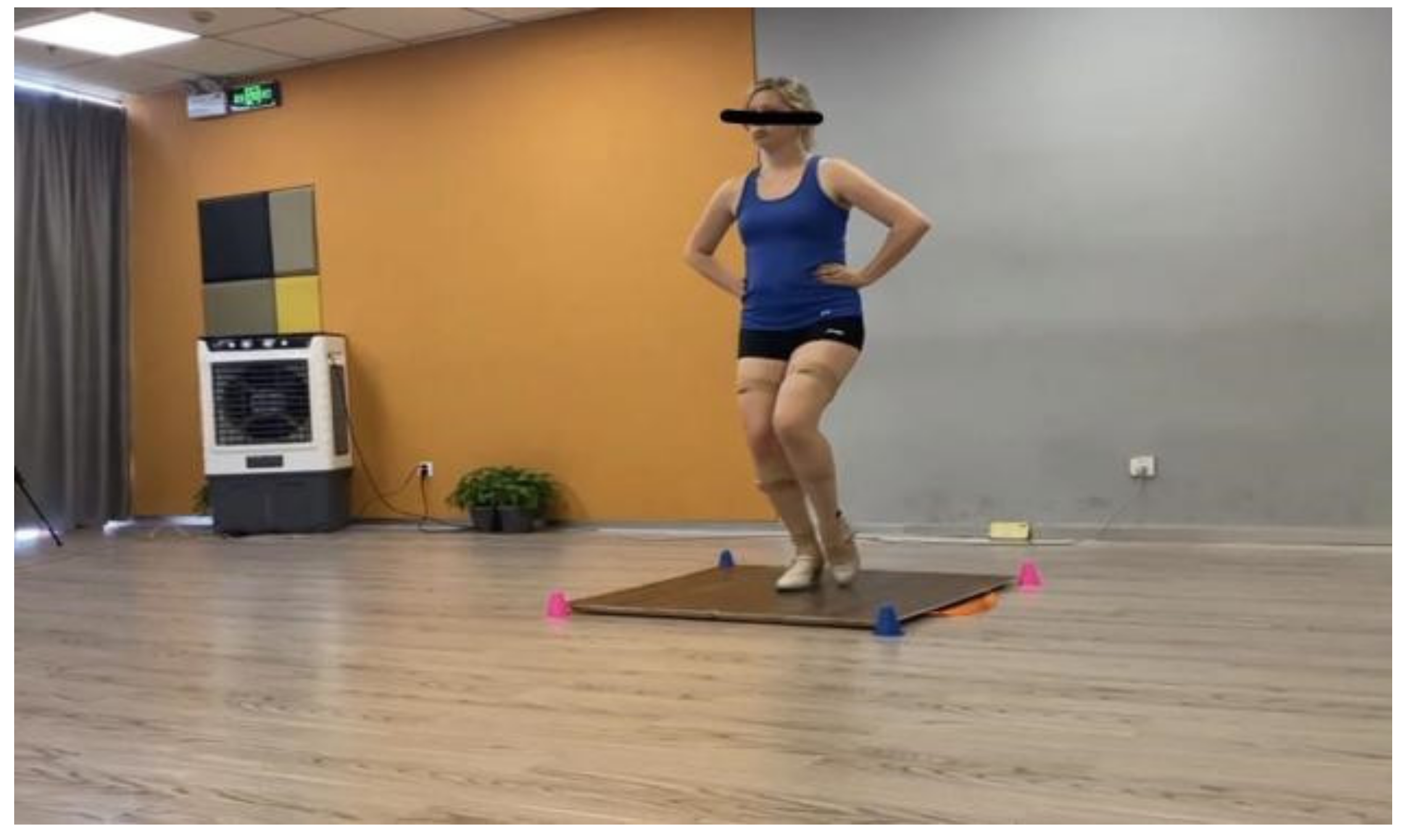

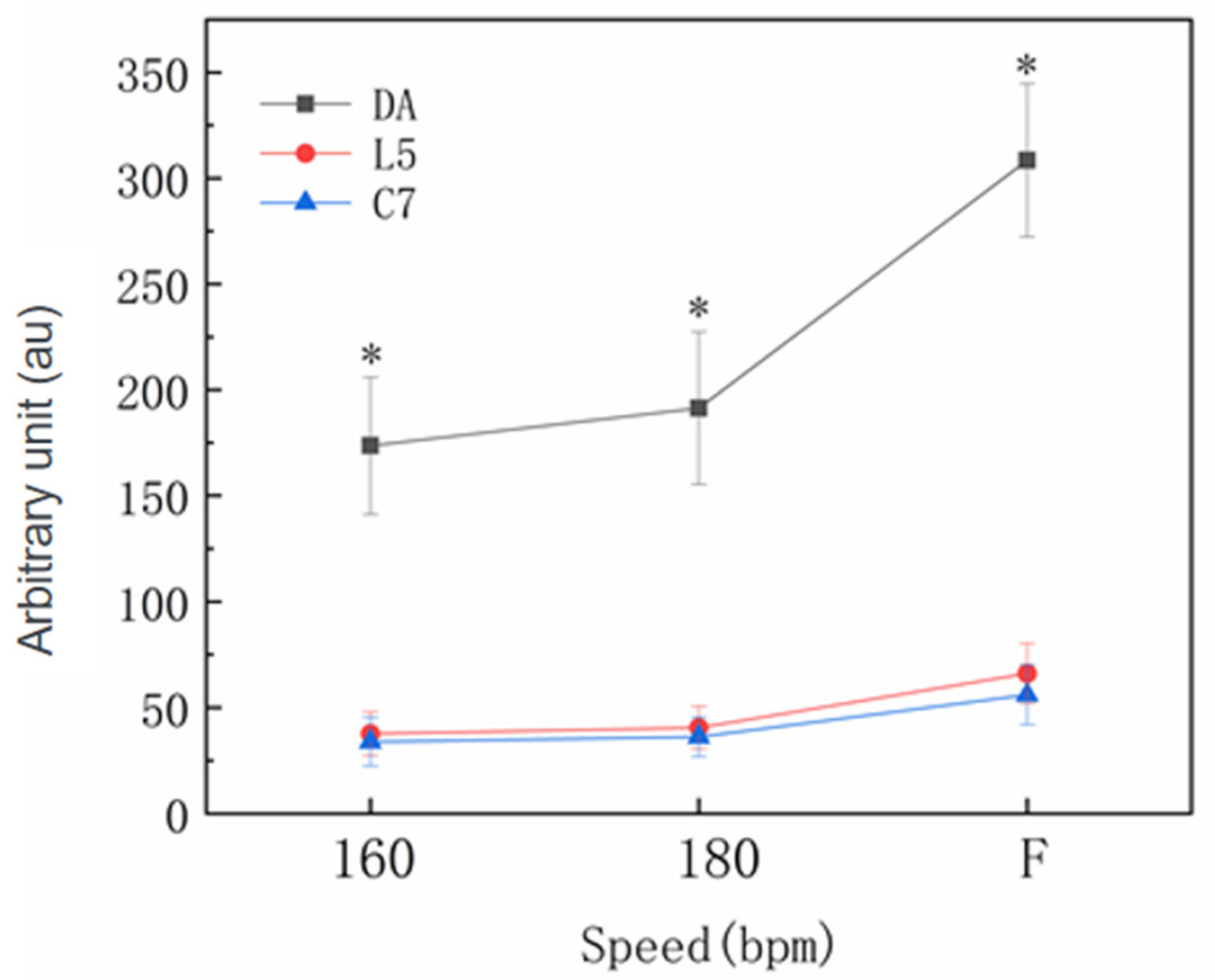
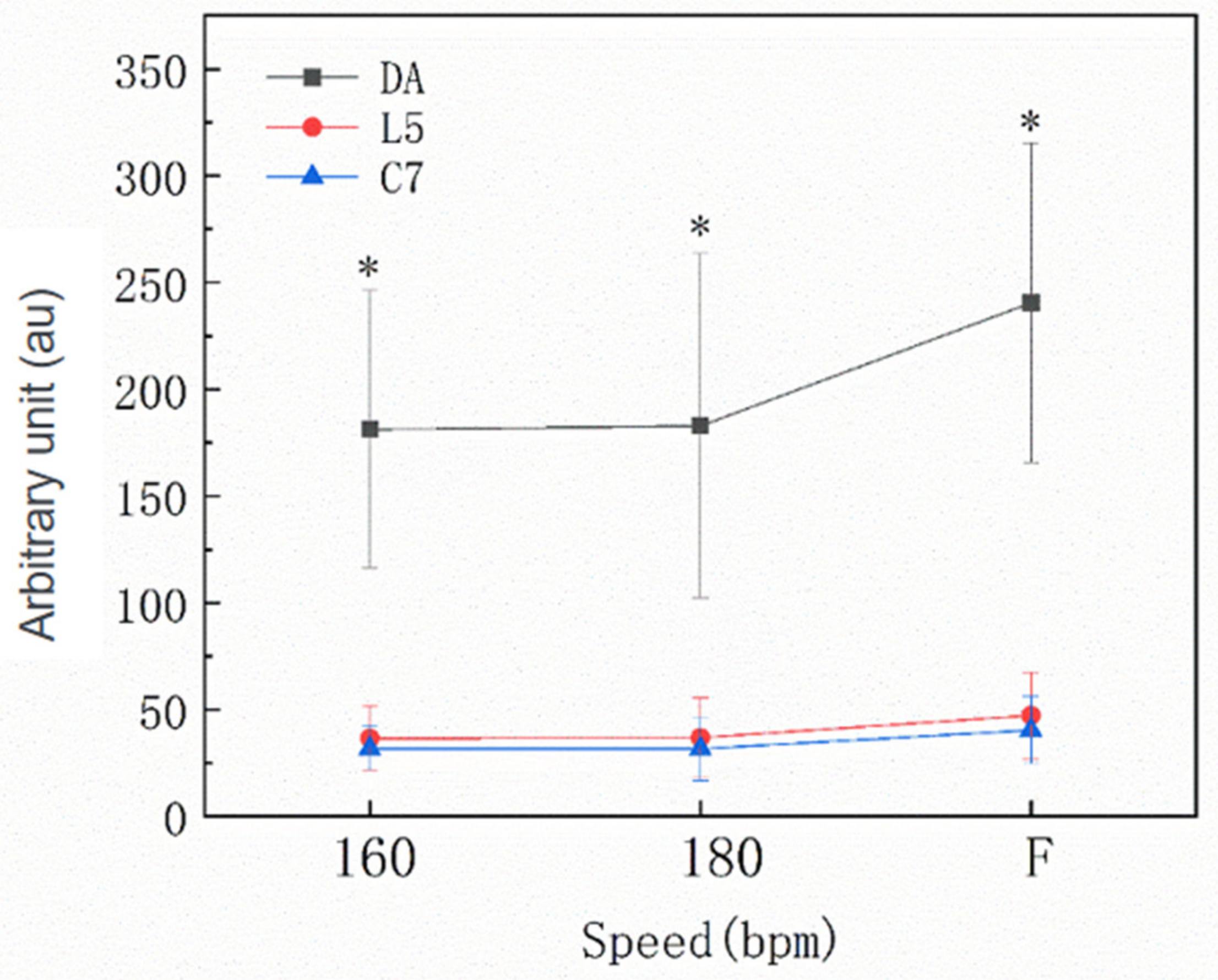
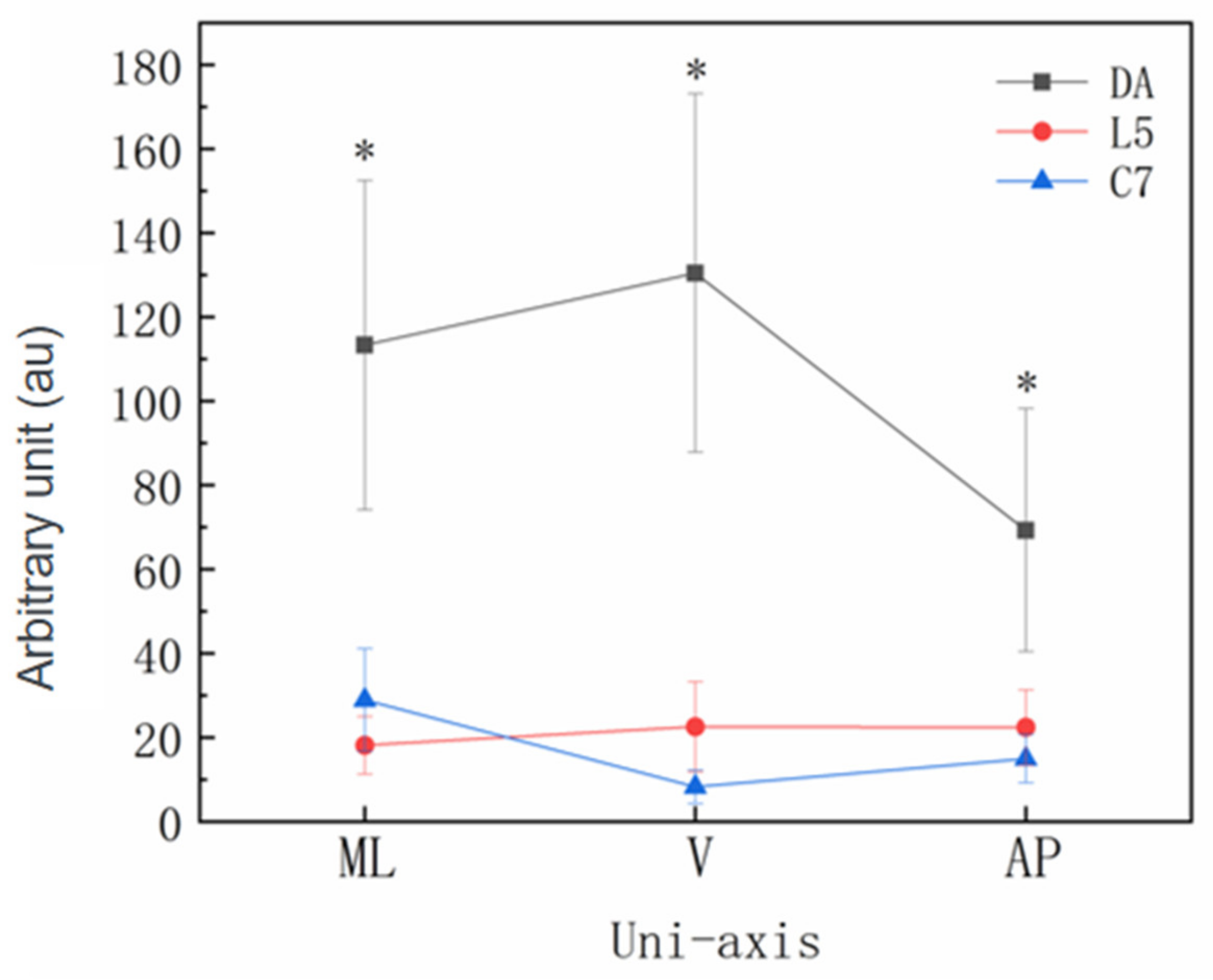
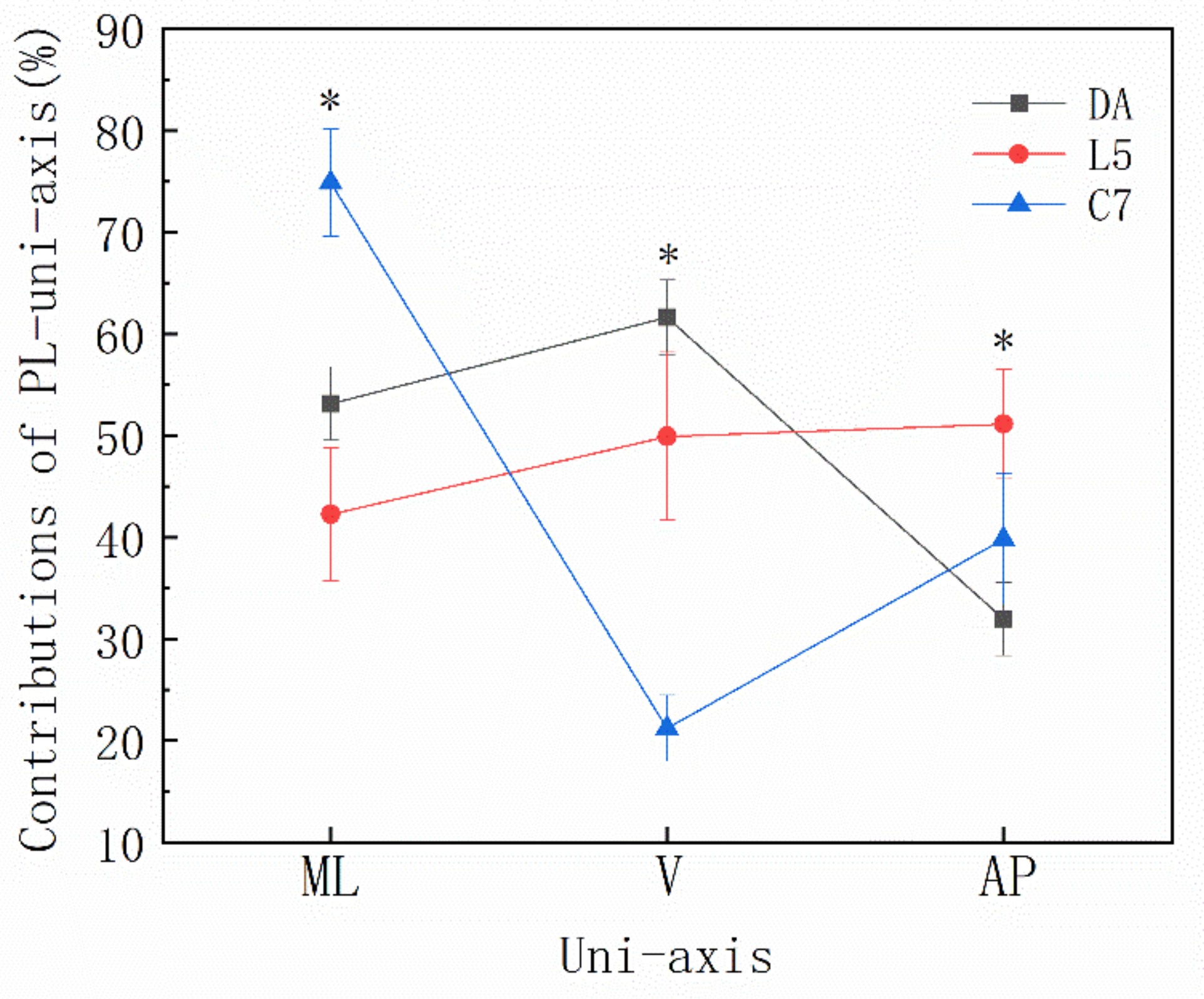
| Characteristics | Group P n = 6 | Group A n = 6 | p |
|---|---|---|---|
| Age (years) | 38.83 ± 7.96 | 34.50 ± 10.67 | 0.148 |
| Height (m) | 1.67 ± 0.10 | 1.62 ± 0.03 | 0.681 |
| Mass (kg) | 63.33 ± 6.38 | 56.17 ± 15.99 | 0.055 |
| BMI (kg/m2) | 22.79 ± 1.95 | 21.36 ± 6.00 | 0.078 |
| Flamenco dance experience (years) | 7.67 ± 4.89 | 1.83 ± 1.17 | * 0.009 |
| Speed | 160 BPM | 180 BPM | * F | |||
|---|---|---|---|---|---|---|
| Group | Group P | Group A | Group P | Group A | Group P | Group A |
| Frequency (Hz) | 5.33 | 5.33 | 6.00 | 6.00 | 8.99 ± 0.78 | 7.08 ± 0.50 |
Publisher’s Note: MDPI stays neutral with regard to jurisdictional claims in published maps and institutional affiliations. |
© 2022 by the authors. Licensee MDPI, Basel, Switzerland. This article is an open access article distributed under the terms and conditions of the Creative Commons Attribution (CC BY) license (https://creativecommons.org/licenses/by/4.0/).
Share and Cite
Zhang, N.; Gómez-Lozano, S.; Armstrong, R.; Liu, H.; Vargas-Macías, A. External Load of Flamenco Zap-3 Footwork Test: Use of PlayerLoad Concept with Triaxial Accelerometry. Sensors 2022, 22, 4847. https://doi.org/10.3390/s22134847
Zhang N, Gómez-Lozano S, Armstrong R, Liu H, Vargas-Macías A. External Load of Flamenco Zap-3 Footwork Test: Use of PlayerLoad Concept with Triaxial Accelerometry. Sensors. 2022; 22(13):4847. https://doi.org/10.3390/s22134847
Chicago/Turabian StyleZhang, Ningyi, Sebastián Gómez-Lozano, Ross Armstrong, Hui Liu, and Alfonso Vargas-Macías. 2022. "External Load of Flamenco Zap-3 Footwork Test: Use of PlayerLoad Concept with Triaxial Accelerometry" Sensors 22, no. 13: 4847. https://doi.org/10.3390/s22134847
APA StyleZhang, N., Gómez-Lozano, S., Armstrong, R., Liu, H., & Vargas-Macías, A. (2022). External Load of Flamenco Zap-3 Footwork Test: Use of PlayerLoad Concept with Triaxial Accelerometry. Sensors, 22(13), 4847. https://doi.org/10.3390/s22134847








